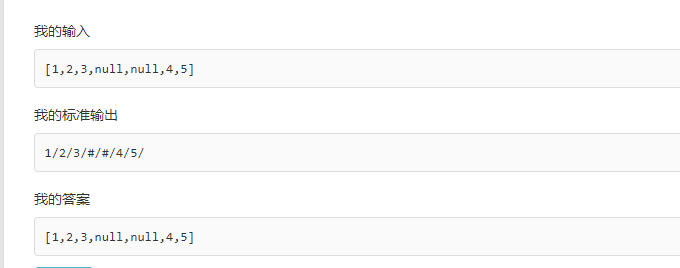leetcode 297二叉树的序列化与反序列化

to_string(x) 将数字x转化为string
atoi(x) 将char转化为int
stoi(x) 将string 转化为int
采用中序遍历的顺序存储,NULL用#表示,以,分隔,O(n)time O(n) space
/** * Definition for a binary tree node. * struct TreeNode { * int val; * TreeNode *left; * TreeNode *right; * TreeNode(int x) : val(x), left(NULL), right(NULL) {} * }; */ /** 使用先序递归序列来进行序列化与反序列化 to_string转化为string以逗号分隔;递归终点x->val==NULL getline(s,str,',');每次读取','之前的字符串;递归终点str=="#" **/ class Codec { public: // Encodes a tree to a single string. string serialize(TreeNode* root) { if(root==NULL) return "#"; else return to_string(root->val)+","+serialize(root->left)+","+serialize(root->right); } // Decodes your encoded data to tree. TreeNode* deserialize(string data) { if(data=="#") return NULL; stringstream s(data); return makedeserialize(s); } TreeNode* makedeserialize(stringstream&s){ string str; getline(s,str,','); if(str=="#") return NULL; TreeNode* root=new TreeNode(stoi(str)); root->left=makedeserialize(s); root->right=makedeserialize(s); return root; } }; // Your Codec object will be instantiated and called as such: // Codec codec; // codec.deserialize(codec.serialize(root));
采用层序遍历的顺序,储存每一层的值,不存在的或者NULL值用#代替,每个位置以'/'结束
/** * Definition for a binary tree node. * struct TreeNode { * int val; * TreeNode *left; * TreeNode *right; * TreeNode(int x) : val(x), left(NULL), right(NULL) {} * }; */ class Codec { public: // Encodes a tree to a single string. string serialize(TreeNode* root) { string res; queue<TreeNode*> q; q.push(root); int flag=1; while(flag){ flag=0; int k=q.size(); for(int i=0;i<k;i++){ TreeNode* p=q.front(); q.pop(); if(p==NULL){ res.push_back('#'); q.push(NULL); q.push(NULL); }else{ int value=p->val; if(value<0) {res.push_back('-');value=-value;} stack<char> s; if(value==0) s.push('0'); while(value){ int e=value%10; s.push(e+'0');value=value/10; } while(!s.empty()){ res.push_back(s.top());s.pop(); } q.push(p->left); q.push(p->right); if(p->left||p->right) flag=1; } res.push_back('/'); } } cout<<res<<endl; return res; } // Decodes your encoded data to tree. TreeNode* deserialize(string data) { if(data.size()==0) return NULL; if(data.size()==2&&data[0]=='#')return NULL; int len=data.size(); vector<TreeNode*> v; for(int i=0;i<len;i++){ if(data[i]=='/')continue; TreeNode* p=NULL; if(data[i]!='#'){ int value=0; int flag=1; if(data[i]=='-') {flag=-1;i++;} while(data[i]!='/'){ value=10*value+data[i]-'0'; i++; } value=flag*value; p=new TreeNode(value); } v.push_back(p); } for(int i=0;i<(v.size()-1)/2;i++){ if(v[i]!=NULL){ v[i]->left=v[2*i+1]; v[i]->right=v[2*i+2]; } } return v[0]; } }; // Your Codec object will be instantiated and called as such: // Codec codec; // codec.deserialize(codec.serialize(root));
测试例子如下:

样例通过为47/48,一个深度为1000的偏二叉树没有通过;


